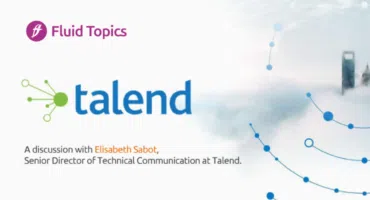Hexagon is a global leader in sensor, software and autonomous solutions. Hexagon Asset Lifecycle Intelligence puts data to work to boost efficiency, productivity and quality and its solutions empower its clients to transform unstructured information into smart digital assets.
Recently Hexagon set out to shift its software products to SaaS, moving from a standard biannual or annual release mode down to four-week build cycles for many products. A key stakeholder in this transformation, the documentation team faced a major challenge: how could technical documentation keep up with such a pace?
What’s more, how could they anticipate and meet the rising needs for information and assistance for customers who are constantly offered new features and more capabilities?
Hexagon turned the challenge into an opportunity to revise and transform its content publishing. By choosing Fluid Topics and moving to dynamic content delivery, Hexagon not only achieved its delivery targets but also realized significant advances in documentation quality and strongly improved customer engagement through a better content experience.

We sat down with Lonnye Yancey-Smith, Executive Manager at Hexagon Asset Lifecycle Intelligence and one of the driving forces behind the documentation transformation the company successfully went through.
The Transition to SaaS and its Documentation Challenge
When working in biannual or annual release cycles, traditional publishing was more than capable of delivering on time. At Hexagon, this meant publishing the final documentation as a PDF or Help file after all development was complete and including documentation with each product build. As the documentation was bundled with the product, changes to documentation often meant a new build needed to be launched and tested before release, necessarily adding time to the product delivery process itself.
With the shift to SaaS and rapid release cycles, however, the traditional publishing approach just wouldn’t work. “We needed to decouple the delivery of documentation from the product build and gain the capability to publish documentation as frequently as needed, including between product releases,” says Lonnye Yancey-Smith, Executive Manager in charge of Technical Documentation and User Assistance at Hexagon’s PPM division. The team also saw an opportunity here to considerably improve the accessibility and the user experience with documentation now that the tech docs were no longer locked in the product.
Hexagon quickly determined that it needed a Content Delivery Platform (CDP) to enable the continuous content delivery the new model required and ensure the optimal usability of technical content.
In a nutshell
The challenges
-
Strong acceleration of the release pace as Hexagon was shifting to SaaS
-
Need for faster iterations of technical documentation, decoupled from product
-
Growing customers’ needs for product information and assistance
The results
-
Two weeks saved in the doc delivery process. Successful move to four-week release cycles
-
Improved documentation quality, accuracy and visibility
-
Self-service information leading to better customer autonomy and engagement
Moving to Dynamic Content Delivery
Powering this continuous content with Dynamic Content Delivery makes perfect sense. By collecting all tech content directly from the authoring sources, transforming it for digital publishing, and delivering it seamlessly to all selected channels, Content Delivery Platforms optimize and streamline the tech doc publication process.
Fluid Topics specifically checked all the boxes for the company’s needs. The native integration of Fluid Topics with Hexagon’s long-established authoring tool, Author-it, meant that the documentation team could self-publish tech documentation as frequently as required, directly from Author-it and in a fully automated process – there was no need for additional IT work or support once the integration was done.
The CDP also offered the company a single place – the documentation portal – where customers, users, and support teams could find all of the documentation and that guaranteed that the freshest content was always available. Importantly, Fluid Topics offered best-in-class search capabilities that enhanced both documentation findability and usability, a point that Hexagon customers rated highly in adoption testing.
“We invited key customers to master classes to train them on our newest product,” explained Yancey-Smith. “A documentation usability test with customers generated a System Usability Scale (SUS) score with Fluid Topics of 81.5, which is considered excellent.”
Hexagon quickly aligned on the choice of Fluid Topics, and the rollout was equally fast. The Author-it integration meant there was no need to change anything on the writing side and, in less than six months, the company was up and running with its product content publicly available on a new documentation portal and was ready to live-publish new content.
“As we shifted our products to SaaS, we moved from annual or bi-annual releases down to four-weeks builds.“
Continuous Content Delivery and Continuous Quality Improvement
Hexagon ’s primary objective in moving to dynamic content delivery was to ensure documentation could keep up with the new build pace. This goal was achieved with ease once the solution was in place. “We’ve saved up to two weeks in the documentation delivery process for large products, which helped us reach our goal of four-week release cycles, ” Yancey-Smith explains. “We couldn’t have kept up with the pace without Fluid Topics.”
Yet the benefits of continuous content delivery didn’t stop with keeping pace with the rapid build schedule. Hexagon also gained the capacity to continually improve their content.
The documentation team is now able to publish new content daily for testing purposes in their User Acceptance Test (UAT) environment. Fluid Topics enabled Hexagon to define very fine access rules, including user group management options, so that pre-release content can be published and visible to internal users to gather feedback before making the new content and updates public. The feedback that the documentation team receives is provided “in context” and linked to the specific topic in question, making integrating changes simple and fast, and improvements continuous, even once the content is made public.
Hexagon also leverages the dedicated content analytics provided by Fluid Topics to increase content accuracy. “Those analytics provide great insights that we can use to directly improve the quality of our doc—insights that web analytics alone can’t provide,” says Yancey-Smith. The documentation team easily sees what users searched for and didn’t find so as to identify what is missing in the documentation.
They also get precise metrics on content usage that they can take action from. “When we see that people spend a lot of time on a particular topic, it raises a flag: it might mean that the documentation needs attention because it’s hard to use, or that the product itself needs attention,” Yancey-Smith adds.
About Hexagon

Hexagon is a leading global provider of information technology solutions that drive productivity and quality across geospatial and industrial landscapes.
Hexagon Asset Lifecycle Intelligence is the world’s leading provider of enterprise engineering design software and project control solutions. Their solutions transform unstructured information to visualize, build and manage safe, efficient smart digital assets.
Providing a Better User Experience
Fluid Topics also allowed the documentation team to drive better customer engagement through their content experience. With the possibility to publish documentation in advance of the releases and visible to a chosen audience only, Hexagon can offer insightful previews to its users and foster product adoption.
“If a major change in a product requires forward planning by customers, we can present these upcoming features to our internal users and customers in advance of the release, giving them the info they need at the right time,” explains Yancey-Smith. This provides customers the time they need to adapt and significantly improves product adoption.
Hexagon also had in mind that unlocking the documentation from the product opened some great possibilities in terms of information accessibility. The company was now able to offer a full self-service experience for users who could access up-to-date and reliable documentation for all Hexagon products through the documentation portal at any time. What’s more, in order to increase the usage and findability of the doc, the company decided to make all content publicly available.
“We believe that this openness was key to the success of our project and to the rapid adoption of online tech doc,” says Yancey-Smith.
Hexagon wanted to push the self-service experience further and give customers a choice of how to access and consult product documentation. Thanks to the portal’s excellent indexing, the users can now easily find the product information they need through search engines like Google. In addition, the documentation is made available in context, integrated with the in-product Help menus and F1 through contextual deep-links that return the relevant information from the central portal without interrupting the user experience with the product with a tedious search.
One final piece in improving the user experience with products lays in helping the people who help customers. Support teams benefit from having all of the documentation in a single easily accessible portal. Best-in-class search means that questions can be answered rapidly with precise, reliable information. More than that, service teams appreciated the capacity to link directly to specific content and documentation to respond to user questions instead of re-explaining and re-writing answers. This truly facilitated support at Hexagon.
“No one anticipated how much Fluid Topics was going to be a game changer for us,” reported Yancey-Smith.
But there was still more good news to come.
“We believe that this openness was key to the success of our project and to the rapid adoption of online tech doc“
Visibility and Scalability Beyond All Expectations
Previously Hexagon’s documentation only shipped with the products they sold. Now, though, the documentation was available online and indexed by search engines for the first time. This supercharged the visibility and findability of the content and lifted Hexagon’s profile almost instantly.
“Before we launched with Fluid Topics in early 2019, the visibility of our documentation via Google was zero,” said Yancey-Smith. “By 2020, though, 42% of the traffic to our documentation site came from web searches.
Thanks to taking their documentation portal public, Hexagon now ranks in the top four results for its product keywords. Traffic to their documentation portal continues to grow, too, with the number of site users increasing 64% between Q1 and Q4 of 2020.
This boost in traffic alongside the precise content analytics provided by Fluid Topics brought major visibility to the documentation usage and the value it brought to customers.
“Now we don’t face questions about whether doc is used,” smiles Yancey-Smith.
From huge time savings in release delivery to increased customer satisfaction, the benefits of moving to dynamic content delivery with Fluid Topics are visible at all stages of the content and customer journey. The return on investment is obvious for the Hexagon doc team, which is getting strong executive support to engage further with Fluid Topics – and it’s all the best, because more can be done.
As the company expands, more technical content from recent product acquisitions are smoothly added to Fluid Topics that can easily integrate these new sources of technical information. Other types of content, such as learning material, should be added soon and contribute in turn to a continuously improved user experience.
“Dynamic Content Delivery has a direct impact on the quality and accuracy of our technical content, and our customers are the first to benefit from it“





